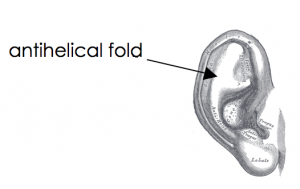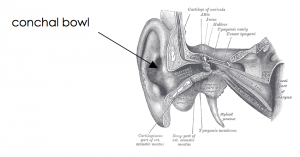Introduction
Many patients with protruding ears consider their ears to be unattractive and may seek the help of a facial plastic surgeon to improve their appearance. If you feel your ears protrude too much, are too large, or are uneven, plastic surgeon Dr. Lawrence Tong can guide you in making the decision about whether or not surgery is the right choice for you.
Otoplasty (Ear Pinning) Benefits
Otoplasty, or ear pinning, is cosmetic surgery of the ears. This procedure can address:
- Ears that are overly large
- Ears that protrude
- Ears that appear uneven or asymmetrical
- Large earlobes
In addition to primary (first-time) Otoplasty, Dr. Tong can correct previous ear pinning that yielded unsatisfactory results.1
Who are Candidates for Ear Pinning?
Anyone who feels their ears are overly protruding, uneven, or too big may benefit from Otoplasty surgery. Children should not undergo Otoplasty until their ears have, for the most part, finished growing. A pediatric patient should also be involved in the decision making process to have the surgery (not solely a parent wanting it for them).
Otoplasty for Protruding Ears
Protruding ears are commonly due to two anatomic variations:
- Effacement of antihelical fold (see below)
- Deep conchal bowl (see below)
- Combination of both
Antihelical Fold:
If you look at an ear, you will notice multiple curves and folds. The antihelical fold is here:
When the fold is effaced (flattened) instead of being bent, the ear tends to protrude
Conchal Bowl
The conchal bowl is a depressed area of cartilage located near the centre of the external ear. It is shaped like a bowl.
When the walls of the bowl are ‘high,’ the entire ear is pushed outwards, producing a protruding ear.
The most common type of protruding ear involves a combination of both these problems. During your consultation, Dr. Tong will assess your anatomy and plan your surgery appropriately to correct your ear protrusion. Asymmetry, unusual ear shape, or large ear size can be corrected during Otoplasty as well.
Otoplasty Incisions
The incisions for Otoplasty are located in the fold behind the ear. The scar heals as a thin line that is difficult to see and is very well hidden due to its location.
Ear Pinning (Otoplasty) Procedure
Dr. Tong performs your Otoplasty in the private surgery centre at 7 St. Thomas Street. This CPSO accredited surgery centre is located within Dr. Tong’s plastic surgery office in downtown Yorkville, Toronto. Dr. Tong performs Otoplasty under general anesthesia or IV sedation. You are asleep and unaware of your surroundings during the procedure.
Dr. Tong starts the procedure by first making the incision behind the ear. Through this incision, he shapes the ear cartilage (the flexible tissue inside the ear) through a combination of bending, partial removal, and stitching into the desired shape. Dr. Tong then corrects the other side, and both sides are checked for adequate correction and symmetry. Once Dr. Tong is satisfied with the appearance, he meticulously stitches the incision back together. After the last stitches are placed, a head dressing is applied and you are gently awakened from anesthesia.2
How to Choose the Best Plastic Surgeon For You
Recovery after Otoplasty
Following your Otoplasty, our staff will transfer you to the post-anesthesia recovery area to be monitored by our nurses. You will be allowed to go home following surgery after the effects of anesthesia have worn off, accompanied by a friend or family member.
You should try to rest as much as possible at home. You may do non-strenuous activities such as watching television and reading. You will go home with a bulky head dressing that Dr. Tong puts on at the conclusion of your surgery. Do not remove it or get it wet until he sees you at your follow up, approximately one week after surgery. Try to sleep in a reclining chair, or use multiple pillows to keep your head elevated when you sleep. This helps decrease swelling. Pain is typically moderate. Dr. Tong prescribes narcotic pain pills which are usually used for one week. The majority of patients return to work (non-strenuous) after one week.
At 5-7 days, you will see Dr. Tong at his 7 St. Thomas Street office to have your dressing and stitches removed. Afterwards, you will be instructed to wear an athletic forehead sweatband when sleeping. This will prevent the ear from being accidentally bent forward while asleep, potentially affecting the result. Avoid strenuous activity until 4 weeks after surgery. Dr. Tong will likely allow you to start light exercise (e.g. walking) 2 weeks after surgery. After the initial postoperative visit, you will follow up with Dr. Tong at 6 weeks, 6 months, and typically one year after surgery. Post-operative photos will also be taken at these visits.
As with any surgery, there are risks involved with having an Ear Pinning procedure. Although the procedure has a very low risk profile, Dr. Tong will make sure to go over the potential problems associated with Ear Pinning during your consultation.
Your Otoplasty (Ear Pinning) Consultation in Toronto
It is important to obtain as much information as possible when considering an elective surgical procedure. Dr. Tong will make sure that you understand all aspects of the pre-surgical, surgical, and post-surgical process. The initial consultation may take over 45 minutes to complete and you will have the opportunity to view photographs of his work. It is our goal to make you an educated patient. We believe that the better educated patient will make better choices about their surgery and their surgeon.
To learn more about how Toronto Otoplasty surgeon Lawrence Tong, MD can help improve the appearance of your ears, set up a Toronto Otoplasty consultation by giving us a call at (647) 492-0648.
If you wish, let us give you a call; just fill out our contact form and we will call you on the same or the next business day.
See Dr. Tong’s work in our Otoplasty Before and After Photos.
Otoplasty (Ear Pinning Surgery) at a Glance
- Pinning the ears too flat against the head
- Ears not looking symmetrical after surgery
- Unnatural look with ear cartilage folds looking ‘too sharp’
1 American Society of Plastic Surgeons. Ear surgery. Available: https://www.plasticsurgery.org/cosmetic-procedures/ear-surgery. Accessed October 16, 2020.
2 American Society of Plastic Surgeons. What are the steps of a ear surgery procedure? Available: https://www.plasticsurgery.org/cosmetic-procedures/ear-surgery/procedure. Accessed October 16, 2020.
Dr. Lawrence Tong has either authored or reviewed and approved this content.


